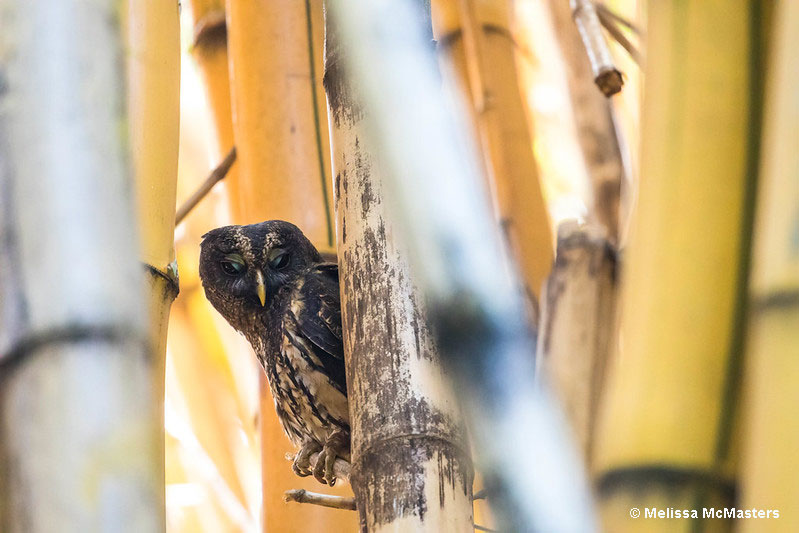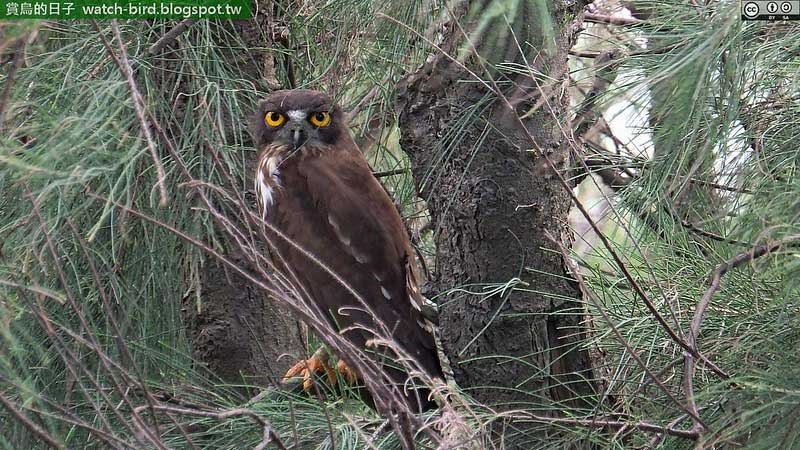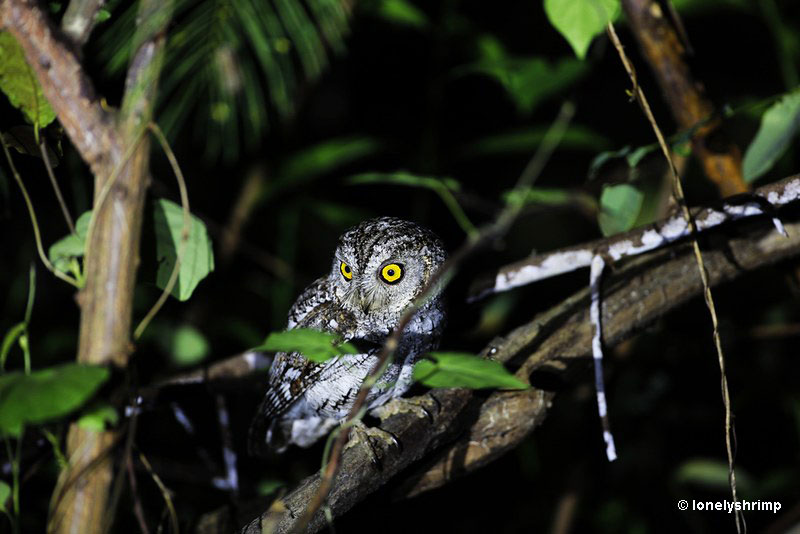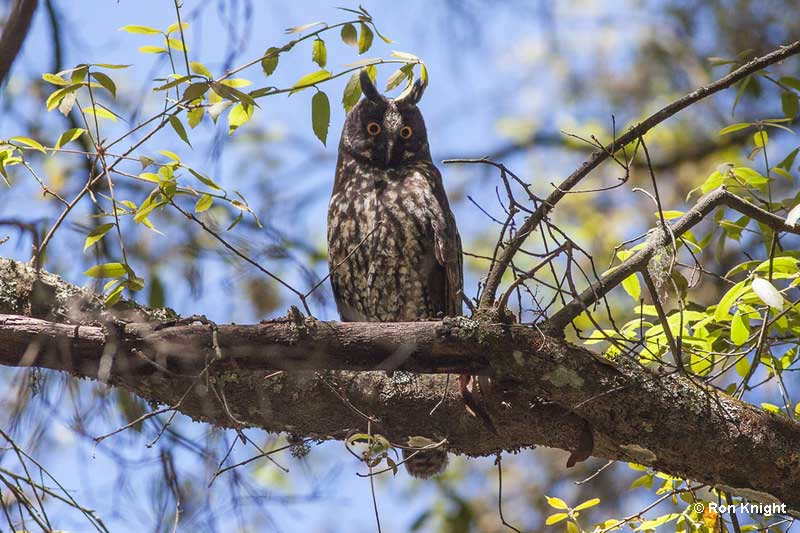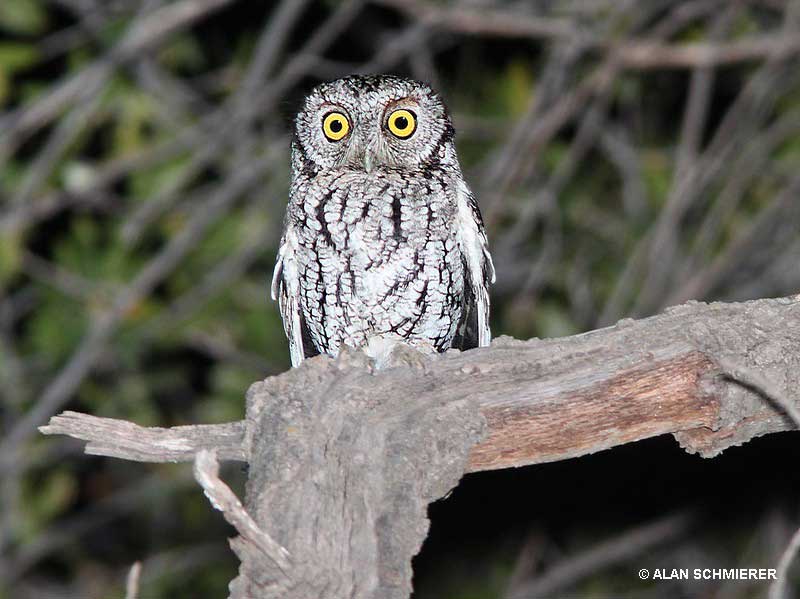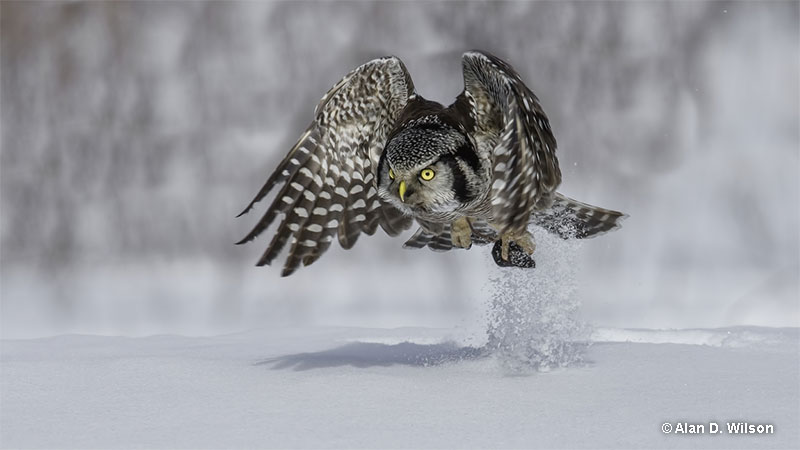
Did you know that North America has 23 species of owls? Although we don’t see them as often as other birds, many owls are common! They get overlooked because most owls are active at night and hide during the day.
Identifying some owls can be tricky, but with a good look, we can recognize all of the owl species in North America.
Learn how to see and identify these amazing birds in this article!
On this page
- Barn Owl
- Barred Owl
- Boreal Owl
- Burrowing Owl
- Eastern Screech Owl
- Elf Owl
- Flammulated Owl
- Great Gray Owl
- Great Horned Owl
- Long-Eared Owl
- Mottled Owl
- Northern Boobook
- Northern Hawk Owl
- Northern Pygmy Owl
- Ferruginous Pygmy Owl
- Northern Saw-whet Owl
- Oriental Scops-Owl
- Short-eared Owl
- Snowy Owl
- Spotted Owl
- Stygian Owl
- Western Screech Owl
- Whiskered Screech Owl
- Tips For Owl Identification
- Types of Owls
Barn Owl
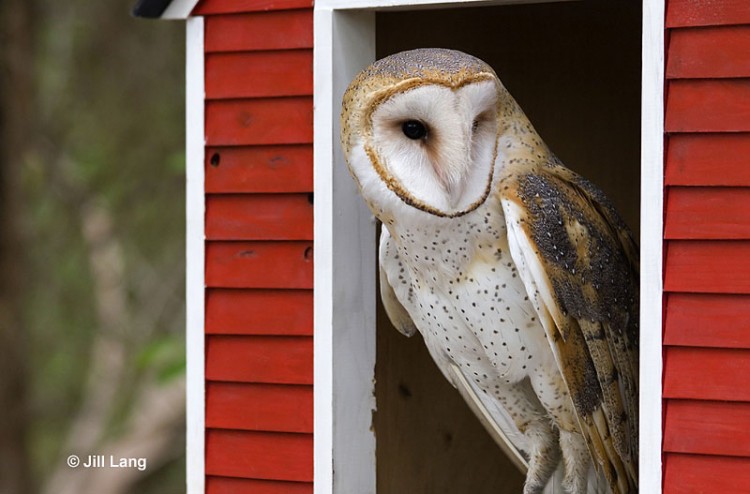
- Range: In Canada, occurs mostly in southwestern British Columbia. In the USA, they live in many areas but are absent from mountains and cold, northern regions. They range north to Washington, Nebraska, Iowa, and New York.
- Length: 16 inches
- Wingspan: 42 inches
The Barn Owl is a medium to large, pale owl with golden tan and gray upperparts, and white underparts. It has a distinctive, white, heart-shaped face.
This beautiful, nocturnal owl hunts in grasslands, on farms, and in other open habitats.
Barred Owl
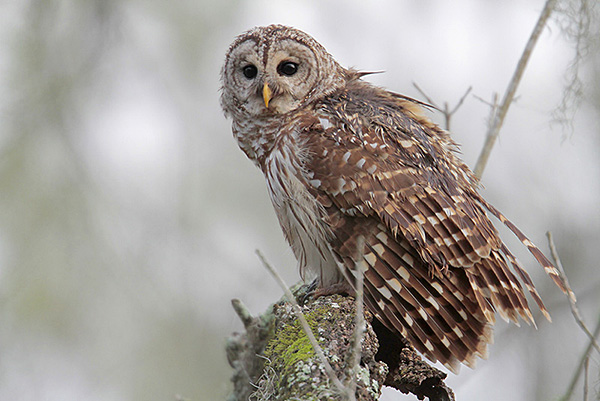
Photograph © Greg Lavaty.
- Range: A permanent resident in most forested areas in Canada, parts of some Pacific Northwestern states, and most of the eastern USA.
- Length: 21 inches
- Wingspan: 42 inches
The Barred Owl is a medium to large owl with a round head and a narrow black border on its pale gray face. It has dark brown upperparts with white markings, and dark brown streaks on its belly.
This common, nocturnal owl lives in a variety of wooded areas.
Boreal Owl
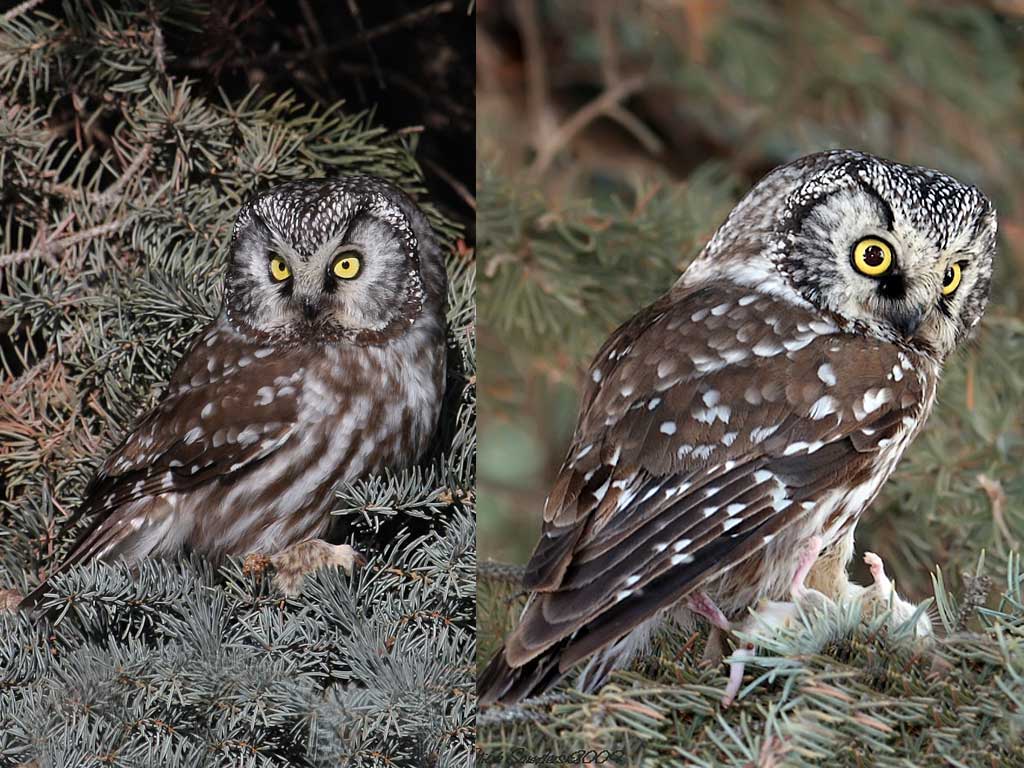
Boreal Owl
- Range: A permanent resident in a large part of Canada, Alaska, and parts of the Cascades and Rocky Mountains. Some migrate to southern Canada and the northern USA.
- Length: 10 inches
- Wingspan: 21 inches
The Boreal Owl is a small owl species with a round or square-shaped head, and white face with a broken black border. It is dark brown with white spotting and has a black and white head.
The Boreal Owl is a reclusive, nocturnal bird of boreal and montane forests.
Burrowing Owl
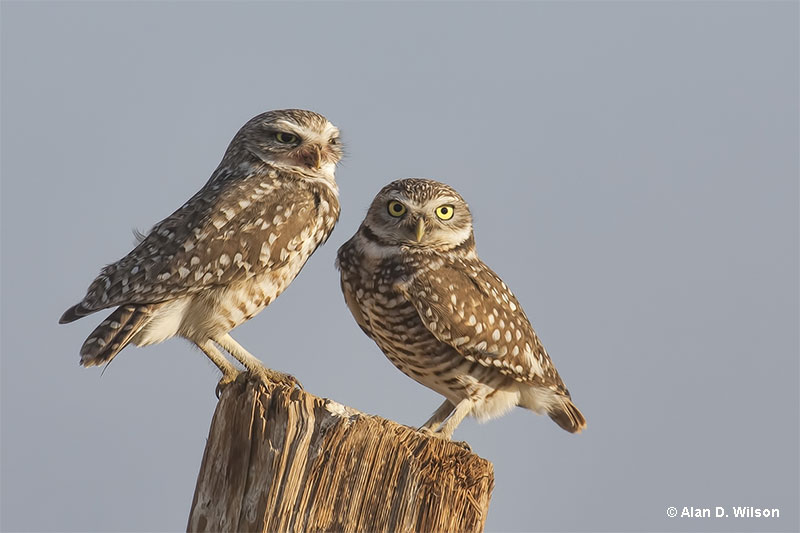
© Alan D. Wilson
- Range: Summer resident in central-southern Canada, the Great Plains, and much of the western USA. Permanent resident in California, Texas, and Florida.
- Length: 9.5 inches
- Wingspan: 21 inches
The Burrowing Owl is a small, long-legged owl with a white throat and white eyebrows. It has a round head, is dark brown with white spots above, and has pale underparts with dark barring.
Burrowing Owls live on the ground in grasslands, deserts, and other open habitats.
Eastern Screech Owl
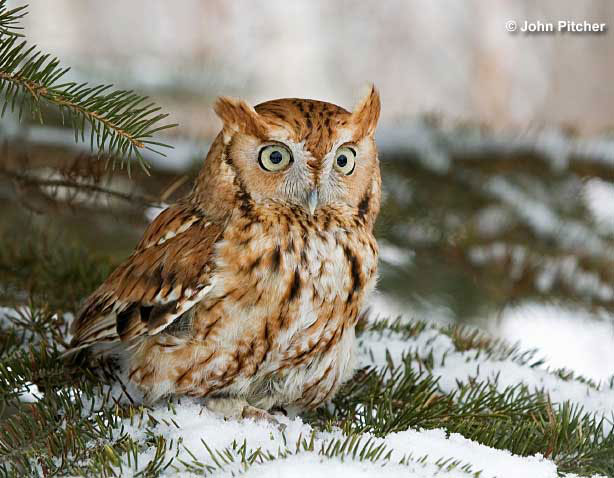
- Range: Permanent resident in parts of southeastern Canada, and in much of the eastern USA.
- Length: 8.5 inches
- Wingspan: 20 inches
The Eastern Screech Owl is a small owl with ear tufts. It can be reddish, brown, or mostly gray, has “V”-shaped pale eyebrows, and some black on the edge of its face. It is also mottled above with some white spotting, and has pale underparts with dark barring and streaks.
Related: Can you have an owl as a pet?
This nocturnal species lives in a variety of wooded habitats.
Elf Owl
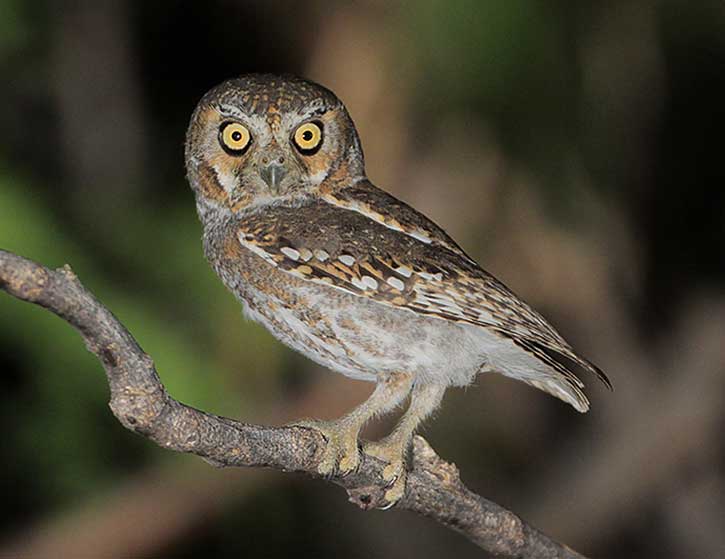
- Range: Summer resident in parts of Arizona, New Mexico, and southern Texas.
- Length: 5.75 inches
- Wingspan: 13 inches
The Elf Owl is a tiny, sparrow-sized owl with a round head and yellow eyes. It is soft gray and brown and has a plain brown face with white eyebrows. It also has white wing bars, and some thick brown streaks below.
This nocturnal owl lives in deserts, riparian zones and evergreen woodlands.
Flammulated Owl
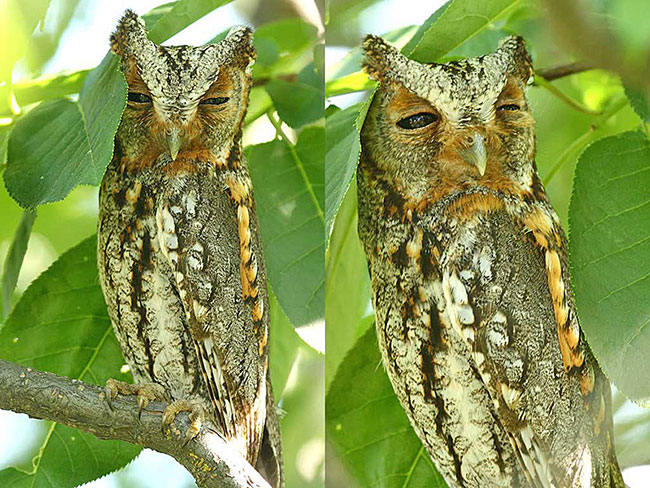
- Range: Summer resident in a small area of southern British Columbia, and in mountains in the western USA.
- Length: 6.75 inches
- Wingspan: 16 inches
The Flammulated Owl is a small, thrush-sized owl with short ear tufts and dark eyes. It is mottled gray and reddish brown with pale eyebrows and some white spotting. This owl also has thick black streaks on mottled gray and white underparts.
This nocturnal owl mostly lives in montane forests of Aspen and Ponderosa Pine.
Great Gray Owl
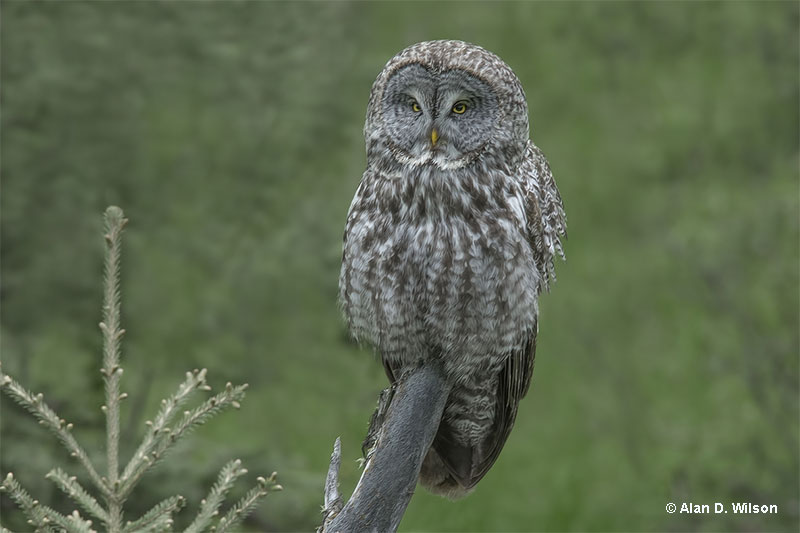
© Alan D. Wilson
- Range: Permanent resident in Alaska, northern Canada east to Ontario, and in the northern Rocky Mountains south to Yellowstone. Some birds winter in the northern USA and southeastern Canada.
- Length: 27 inches
- Wingspan: 52 inches
The Great Gray Owl is a huge owl with a big, round head, and is dark gray with some pale mottling. It has a narrow black border on its face and two white marks on its throat.
This big owl can be active day and night in coniferous forests.
Great Horned Owl
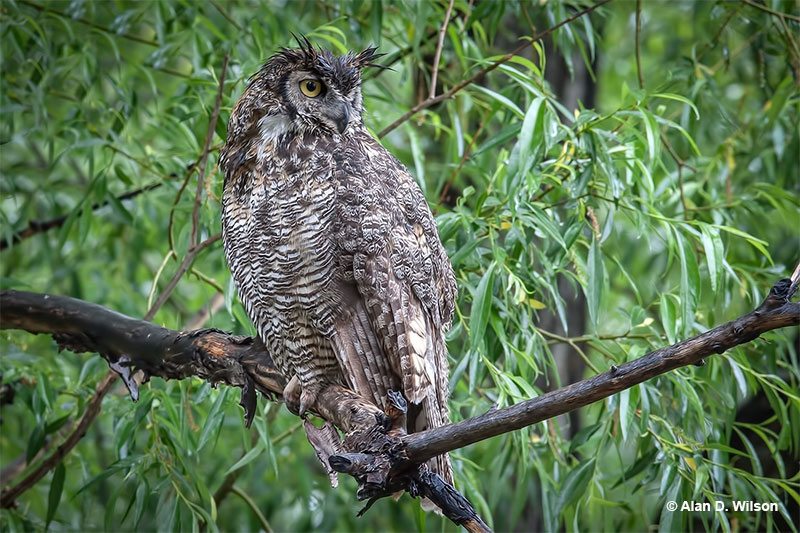
- Range: Permanent resident in much of Alaska, Canada, and the USA.
- Length: 22 inches
- Wingspan: 44 inches
The Great Horned Owl is a big, bulky owl with big ear tufts and a black beak. It is mottled gray and brown, has a rufous or gray face, and fine black barring on its underparts. This owl also has a white throat and some dark marks on its breast.
Related: Do owls eat cats?
This nocturnal owl species lives in every possible habitat, including urban areas.
Long-Eared Owl
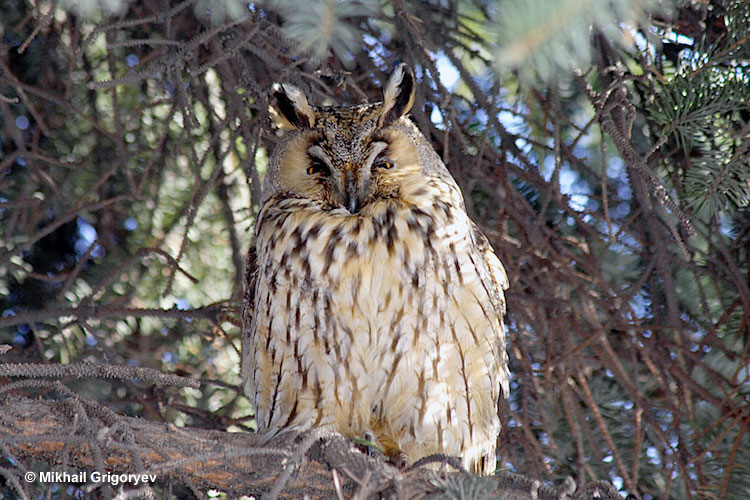
- Range: Migrant in southern Canada, resident and winters in much of the USA. Absent from parts of the Pacific Northwest and southeastern states.
- Length: 15 inches
- Wingspan: 36 inches
The Long-eared Owl is a medium-sized, slender owl with long ear tufts. It has an orange face, is mottled gray above, and has dark brown streaks and marks on pale underparts. This owl also has long wings with a rufous patch in its primaries.
This nocturnal owl frequents coniferous woodlands near meadows.
Mottled Owl
- Range: A Mexican and neotropical species. Rare vagrant in the lower Rio Grande Valley of Texas.
- Length: 12 inches
- Wingspan: 34 inches
The Mottled Owl is a smallish to medium-sized owl with a round head, dark eyes, and a yellowish beak. It is dark brown above and on its head, and has pale eyebrows. It also has buff underparts with dark brown streaks.
This nocturnal owl lives in tropical woodland habitats.
Northern Boobook
- Range: A migrant species from eastern Asia. Rare vagrant to western Alaska.
- Length: 11.8 inches
- Wingspan: 26.5 inches
The Northern Boobook is a smallish to medium-sized, slender owl with a round head and big yellow eyes. It is mostly dark brown with a black beak, has a bit of white between its eyes, and dark streaks on pale underparts. It also has long wings and a fairly long tail.
This nocturnal species lives in wooded habitats.
Northern Hawk Owl
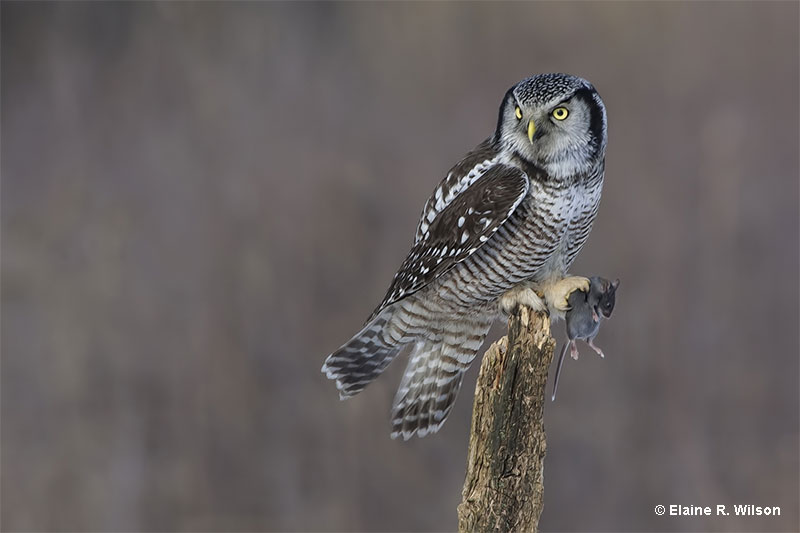
© Elaine R. Wilson
- Range: Permanent resident in Alaska and a large area of Canada. In the winter, some birds reach the northern USA and southern Canada.
- Length: 16 inches
- Wingspan: 28 inches
The Northern Hawk Owl is a slender, smallish to medium-sized owl with a square-shaped head and long, pointed tail. It has a black and white head, and fine barring on pale underparts. It also has some white spotting on dark brown upperparts.
Related: Where do owls nest & build their nests
This diurnal owl frequents coniferous forest habitats.
Northern Pygmy Owl
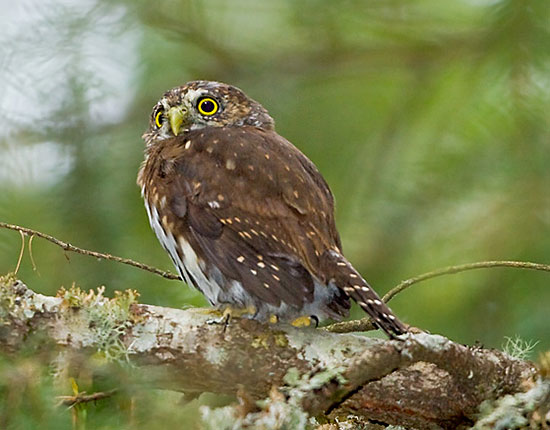
- Range: Permanent resident in the southern half of British Columbia and parts of Alberta, and in mountains and coastal forests of the western USA.
- Length: 6.75 inches
- Wingspan: 12 inches
The Northern Pygmy Owl is a small, grayish-brown owl with two large black marks on the back of its head. It also has small white spots on its head, breast, and flanks, a longish banded tail, and dark streaking below.
This uncommon diurnal owl lives in oak and coniferous forest habitats.
Ferruginous Pygmy Owl
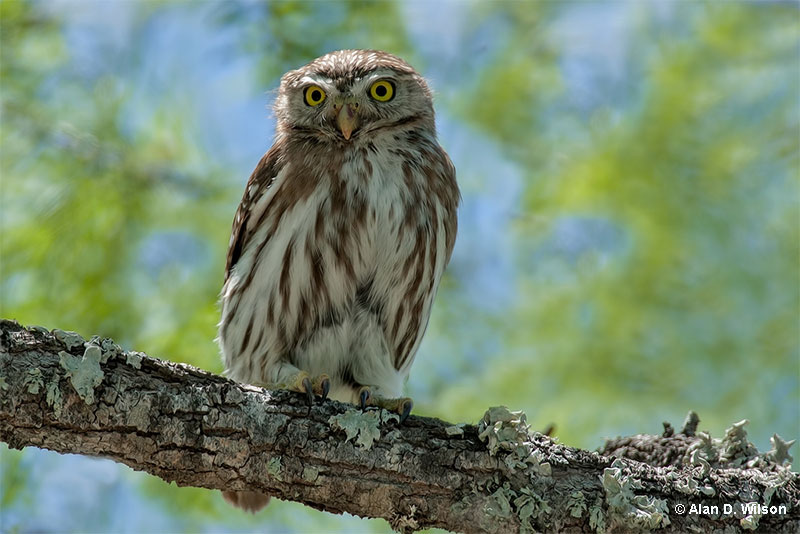
- Range: Permanent, rare resident in a few small areas of southern Arizona and southern Texas.
- Length: 6.75 inches
- Wingspan: 12 inches
The Ferruginous Pygmy Owl is a small, gray and reddish-brown owl with two large black spots on the back of its head. It has a reddish tail with dark bars, fine white streaks on its crown, and brown streaks on pale underparts.
This rare diurnal owl species lives in desert and subtropical forest habitats.
Northern Saw-whet Owl
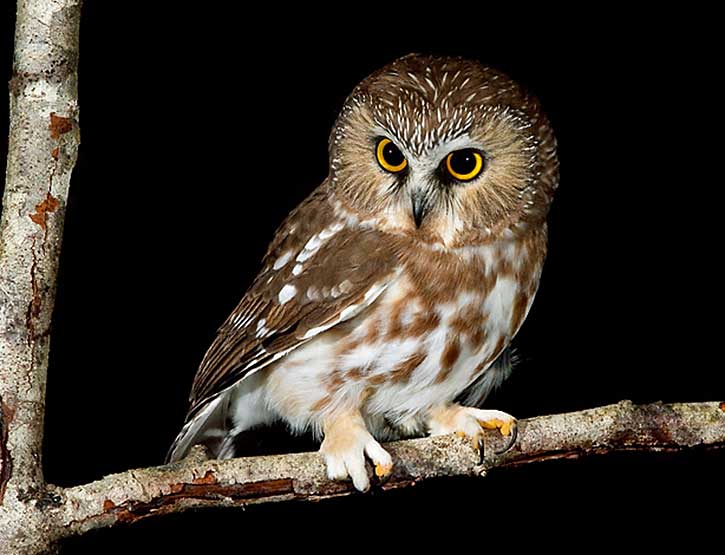
- Range: Lives in coniferous and mixed hardwood forests of Alaska, a large area of Canada, and parts of the northern and western USA.
- Length: 8 inches
- Wingspan: 17 inches
The Northern Saw-whet Owl is a small, dark brown owl with a round head and brown streaks on white underparts. It also has some pale streaks on its head, a brown and white face, and some white spotting on its back.
This nocturnal owl lives in forested habitats.
Oriental Scops-Owl
- Range: Lives in eastern and Southern Asia. A rare vagrant to western Alaska.
- Length: 7.4 inches
- Wingspan: 20.4 inches
The Oriental Scops-Owl is a small owl with ear tufts, and dark barring and streaks on pale underparts. They can be grayish-brown or reddish and have short pale eyebrows. They also have some black on the edge of their faces and some white marks on their backs.
This nocturnal species occurs in wooded habitats.
Short-eared Owl
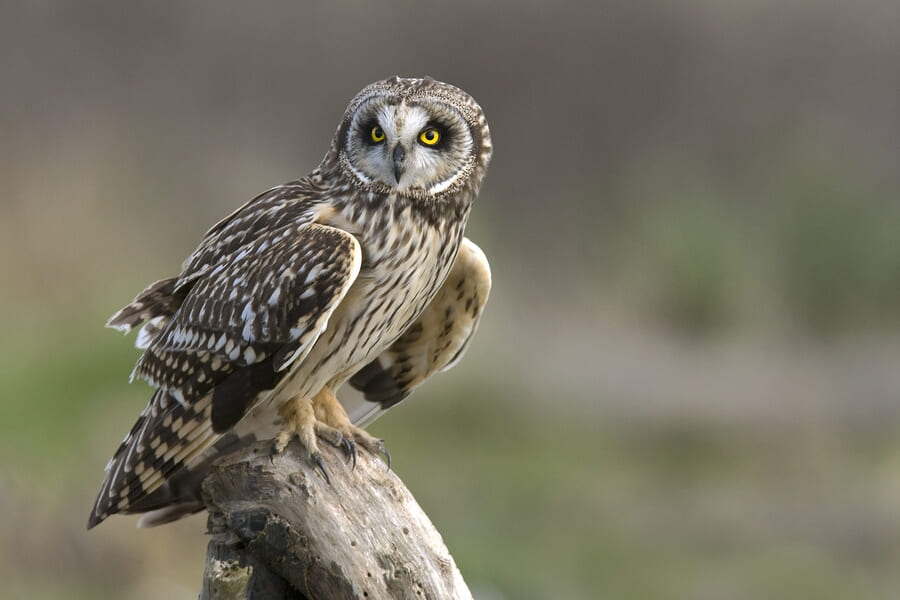
- Range: Summer resident in Alaska, Canada, and the western and central USA. Northern birds migrate to the USA, south to California and Texas.
- Length: 15 inches
- Wingspan: 38 inches
The Short-eared Owl is a medium-sized, pale brown owl with dark eye patches on a pale face. They have a dark breast and streaks on pale underparts. This species has long wings with buff wing patches.
This owl is active day and night in open fields.
Snowy Owl
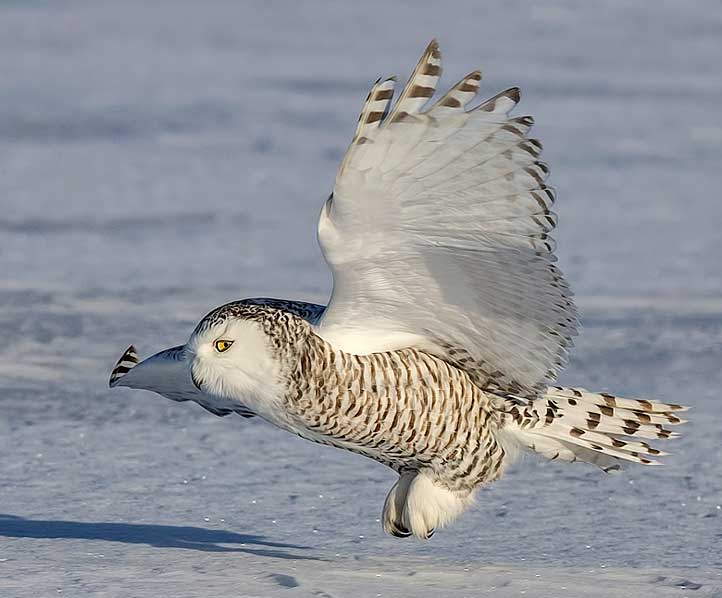
- Range: Summer resident in northern Alaska and northern Canada. It winters in Canada and the northern USA.
- Length: 23 inches
- Wingspan: 52 inches
The Snowy Owl is a big, mostly white owl with a round head and yellow eyes. Some males are mostly white but most have some small dark marks. Females and young birds have white faces and varying degrees of black barring.
This owl species is active during the day and lives in wide-open habitats.
Spotted Owl
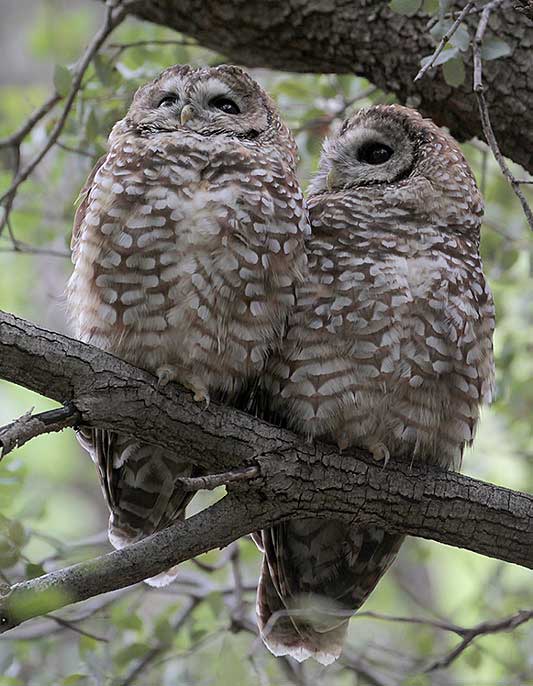
Photograph © Greg Lavaty
- Range: A permanent resident in the Pacific Northwest, the Sierra Nevada, and mountains in the southwestern USA.
- Length: 17.5 inches
- Wingspan: 40 inches
The Spotted Owl is a medium-sized owl with a round head, dark eyes, and a narrow black border on its pale brown face. It also has dark brown upperparts with pale markings, and dark brown and white spotting on its underparts.
This uncommon, nocturnal owl lives in mature coniferous and oak forests.
Stygian Owl
- Range: A permanent resident in various parts of Mexico and the Caribbean south to South America. A rare vagrant to southern Texas.
- Length: 16.5 inches
- Wingspan: 38 inches
The Stygian Owl is a medium-sized, dark, slender owl with ear tufts and yellow eyes. It has a white mark on its forehead, a blackish face, and dark streaks and barring on pale underparts. This owl also has long wings.
This vagrant owl lives in a variety of tropical woodland habitats.
Western Screech Owl
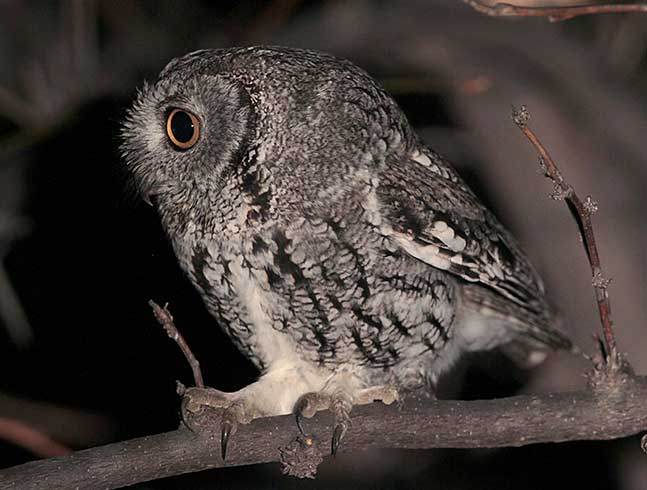
- Range: Permanent resident in British Columbia and the western USA.
- Length: 8.5 inches
- Wingspan: 20 inches
The Western Screech Owl is a small brown or gray owl with ear tufts. It has “V”-shaped pale eyebrows, and some black on the edge of its face. This owl also has mottled upperparts with some white marks, and pale underparts with dark barring and streaks.
This nocturnal owl species lives in a wide variety of woodland and open habitats.
Whiskered Screech Owl
- Range: Permanent resident in mountains of southeastern Arizona.
- Length: 7.25 inches
- Wingspan: 17.5 inches
The Whiskered Screech Owl is a small, gray owl species with ear tufts and yellow-orange eyes. It has “V”-shaped pale eyebrows, and some black on the edge of its face. This bird is also mottled gray and white above, and has thick, short dark streaks and barring on pale underparts.
This nocturnal owl resides in montane oak and coniferous woodlands.
Tips For Owl Identification
Owls can be confusing, but there are some tricks to help recognize them. These tips to identify owls will help!
- Size – The size of an owl is a good first step to identify it. Owls can be small, about the size of a crow, or, around the size of a Red-tailed Hawk. Get a good idea of the size of the bird and go from there.
- Range – Some species can be identified by just finding out where they live. For example, a small, tufted owl seen in many parts of the west is probably a Western Screech-Owl.
- Head shape and face pattern – As with many birds, owls can often be identified by getting a good look at the shape of the head and the face pattern. See if the owl has a rounded head, if it has ear tufts, or a square-shaped head, and then focus on the color and pattern on its face.
- Pattern on the underparts – Another good field mark to focus in on is what the underparts look like. Are they barred or does the bird have streaks? Does it have thick streaks or fine streaks combined with barring? Maybe the bird has spotting below or has plain white underparts.
Types of Owls
Not all owls are the same. They have different shapes and behaviors suited to the habitats they live in and the prey they catch. The following are a few different types of owls.
Barn Owl – This distinctive owl is not in the same family as the other owls in North America. With that in mind, it’s no wonder it has such a distinctive, heart-shaped face, and pale, mostly uniform plumage.
Day-Flying Owls – Most owl species are active at night, but some catch prey in the day. The most diurnal species in North America are Snowy Owl, pygmy-owls, and the Northern Hawk Owl. Short-eared Owls, Great Gray Owls, and Barred Owls can also be active during the day.
Terrestrial Owls – A few owls live in open areas and spend most of their time on the ground. True to its name, the Burrowing Owl lives in holes in the ground and is often seen perched on open bare earth, or on a rock.
Owls Also Live in Open Habitats – Many owls live in or near forests, but others need open habitats. The Barn Owl and Short-eared Owl forage for rodents in grasslands and other open habitats. Snowy Owls prefer wide-open, bare fields similar to their summer tundra homes (and is why we often see them at airports), and Long-eared Owls roost in woods but hunt ay night in meadows and fields.
Migrant vs. Resident Owls – Some owls live in the same place all year long, but others are migratory. Several species migrate to the northern USA, especially when there is less food available on their Canadian breeding grounds. Three species, the Flammulated Owl, Elf Owl, and Burrowing Owl, migrate to Mexico for the winter.


